When it comes to cryptocurrency investing, we should never do anything by chance. We should invest based on our knowledge of the market's previous performance, predictions of future trends, and projections of how it will behave in the future. Technical analysis tools are really beneficial to us at this point.

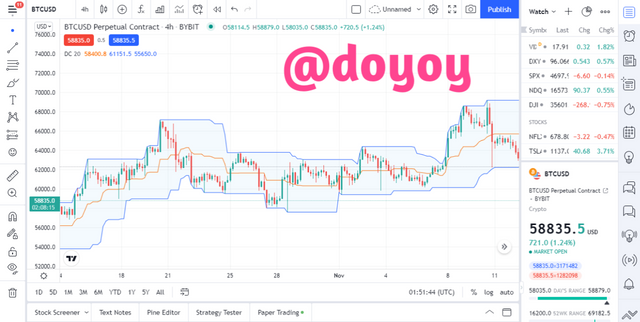
The Donchian Channel is one of these tools, and it's a name I've never heard of before. The Donchian Channel, in simple terms, is a trend indicator created by an expert. The Donchian Channel is a plot showing the highest and lowest prices across time, as well as the current price.
When we apply this indicator to our chart, it appears as a striped indicator similar to Bollinger bands, but the borders are more rigid and do not extend as much as Bollinger bands. This indicator can also be used to predict when the current trend will return or to identify overbought conditions.
The Donchain channels Indicator was created by a trader named Richard Donchain in the mid-twentieth century, and it was named after him. In order to identify market patterns, he created this indicator.
The Donchain channels Indicator, as previously said, is made up of three lines: an upper band, a lower band, and a middle line. The upper band represents the greatest price at any given time, while the lower band represents the lowest price at any given time, with the center band being the average of the two. The Donchain channels are the spaces between the upper and lower bands.
HOW IS DONCHAIN CHANNELS CALCULATED?
CALCULATION OF THE HIGHER BAND
The time period is selected.
The highest highs of each unit over that time span are examined...
The highest of these values is chosen.
Our higher frequency band was thus prepared.
Our higher frequency band was thus prepared.
CALCULATION OF THE MIDDLE BAND
A time frame is chosen.
Within the given time period, in each unit;
The average is calculated for the highest highs (HH and) and lowest lows (LL) (LL).
MC= ((HH)+(LL))/2
Where MC is the middle channel
CALCULATION OF THE LOWER BAND
The time period is selected.
The lowest lows of each unit over that time span are examined...
The lowest of these values is chosen.
Our lower band was thus prepared.
As a result, our DC was ready.
WHAT ARE THE DIFFERENT TYPES OF USES AND INTERPRETATIONS OF THE DONCHIAN CHANNELS?
Traders use Donchain channels in one of three ways to discover trading opportunities in a market. Traders use the Donchain Channels Indicator to identify reversals by measuring market volatility, breakout positions, and overbought and oversold situations. These three applications will be discussed in further depth below.
VOLATILITY: As I previously stated, one of the key reasons for Richard Donchain's development of the Donchain channels was to measure market volatility, and the Donchain channels, like the Bollinger bands, are a useful indication for measuring volatility. The movement of the upper and lower bands provides a precise and clear picture of market volatility at any given period.
HIGH VOLATILITY: When the gap between the upper band or channel and the lower band or channel is longer, as indicated in the image below, volatility is regarded to be high in the market. The wider the gap between the upper and lower bars, the more volatile the market is. And we all know how volatile asset prices are in an unstable market.
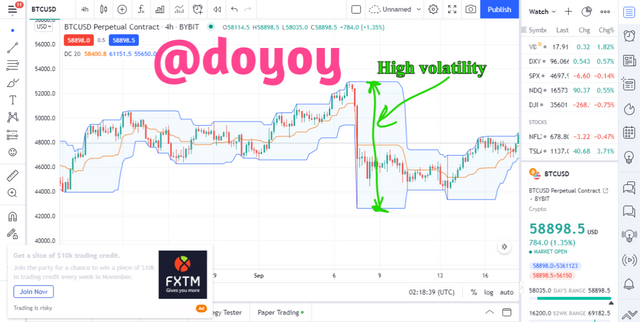
LOW VOLATILITY: In contrast to High Volatility, when the gap between the upper and lower bands is shorter, the market is deemed to be less volatile. That is, the closer the upper and lower channels are, the less volatile the market is and the more stable the price of a financial item is.
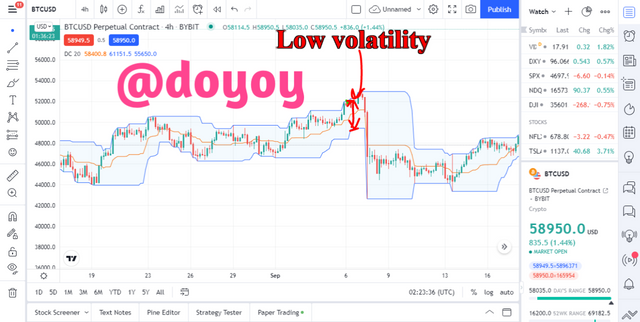
BREAKOUT: A breakout occurs in a bullish market when price is in an Overbought position and instead of reversing downward, price breaks and continues upward. In a bearish market, a breakout occurs when price is in an oversold position and instead of reversing upward, price breaks and continues to fall.
OVERBOUGHT AND OVERSOLD ZONES
The Donchain channel, as previously said, is used to identify overbought and oversold market conditions.
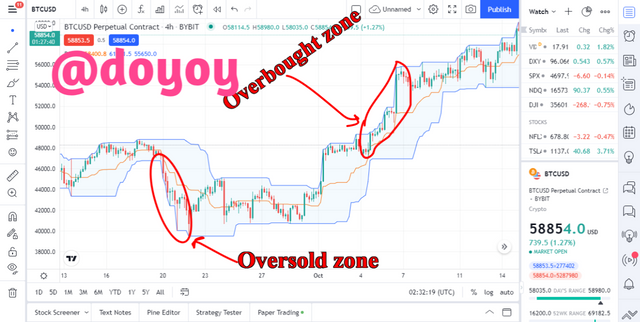
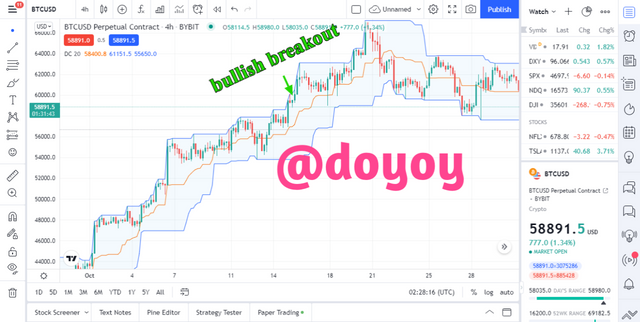
OVERBOUGHT ZONE: Overbought positions, often known as zones, are areas where an asset has been overpriced. When the price of an asset is on an uptrend, usually in a bullish market, it enters an overbought zone.
This position usually indicates that there are more buyers than sellers in the market, causing the price to rise. When the price chart touches and likely pushes the upper channel higher, the overbought positions can be identified using the Donchain channels.
When the price reaches the upper channel (band), it usually indicates a possible price reversal downward. When the market is overbought, it's a favorable time to place sell orders because the price is predicted to fall.
OVERSOLD ZONE: An oversold position or zone is the opposite of an overbought condition. Oversold Zones are indicators of a financial asset's devaluation.
Oversold positions are most common during a downtrend, when prices are consistently making lower lows, and they indicate that selling are outnumbering buyers in the market, driving the price down.
When the price chart touches the bottom channel or band, the oversold condition is identified using the Donchain channels.
Oversold positions are usually solid indicators of a market reversal, therefore they're good places for traders to place a buy order since prices are predicted to climb.
MAKE 1 INNING USING THE DONCHIAN CHANNEL BREAKOUT STRATEGY
It is always necessary to take a close look at the various bands and candles when performing Breakout Strategy using the Donchain Channel.
As soon as one of the candles in the set time interval rises and touches the top band, an uptrend is signaled, indicating that the price is likely to rise. In other words, the asset's current high price may be broken, resulting in an uptrend. As a result, a new highest band has developed in the chart's uptrend, and there may be a modest decline at any time. As a result, it creates a favorable entry point, allowing investors to participate in the upward trend.
It's also a good idea to set a stop loss to limit your losses and maximize earnings if the trend changes.
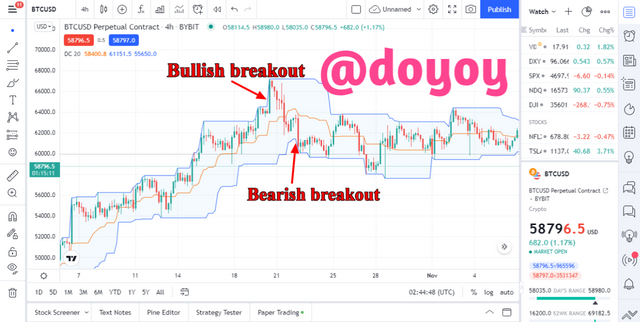
There was a strong bullish run in the figure above, but as soon as the candle went downward to contact the lower band, a downtrend began.
And as this indicates a trade exit, I've placed a sell order here.
USING THE REVERSAL AND RETRACEMENT STRATEGY
The Donchain channels can be used to establish reversal and retracement strategies. When the middle band is broken, there is a high probability of a trend reversal in the chart. Bullish and bearish trends can also be explained by the intersection of the middle band and the lowest/highest candle.
In certain situations, it may not be a signal for bullish or bearish trends, which is why, in order to execute proper technical analysis, it is always necessary to use one or more indicators/strategies.
It's also worth noting that chart candle movement in a bearish phase tends to fall between the lower and middle bands, but in a bullish time, it tends to fall between the higher and middle bands.
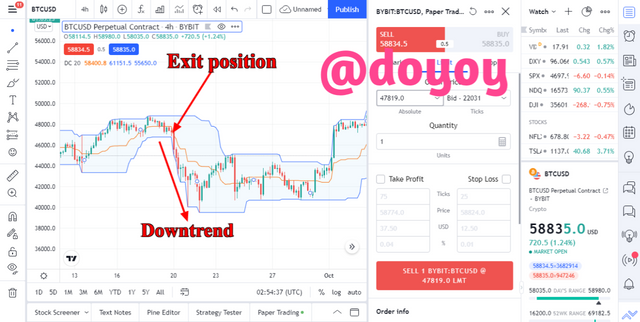
The middle band may be seen cutting the candlesticks downward in the image above. This indicates that there will be a decline and a bullish surge in the near future. As a result, in order to benefit, I placed a sell order.
If the middle band intersects the upper half of the candlesticks, it indicates that there will be an uptrend/bullish period, and I will make a buy other order.
CONCLUSION
Using this indicator, which is one of the most essential technical analysis tools in our analysis will undoubtedly be advantageous. But, as I said in my writeup a signal received from any indicator alone should not be entered into or removed from position.
Different indicators should be used to investigate the received signal.